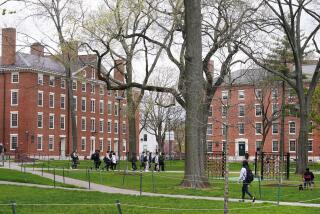The Larger the Class, Lower the Standard
- Share via
A student teacher sadly asks, “How can I, a new teacher, hope to handle these class loads when I see veteran teachers who can’t?”
*
If my mail is accurate, there are a lot of folks out there affected by huge class sizes. Not only teachers, but parents, counselors, college students and those considering teaching as a career. Furthermore, these concerned readers informed me of some conditions far worse than I had realized.
Although my original column focused on the high schools, it is clear that elementary school teachers not covered by class size reduction legislation continue to deal with uncomfortably large numbers. At many schools, little Johnny will move from a third-grade class of 18 to a fourth-grade class of 34 and he will face those class sizes and larger right on through high school.
Thank heaven for those first years, but there are equally important academic tasks still to come, and those tasks require a good deal of individual attention.
Many parents affected by large class sizes wrote in appalled by how little work their kids bring home. One mother reported that her daughter had not written one thing in her English class in 10 weeks of school; all English work was assessed by Scantron (a machine that scores objective tests). At Back to School Night, the reason became clear: there were 45 kids in her daughter’s class. I’m not excusing the lack of rigor here, but it’s a miracle the teacher survives the day, let alone grades essays.
One has to ask what toll is this taking on these students’ education? Another South County parent was stunned to learn that her son’s classes had grown from 35 to 40 because school construction could not keep pace with real estate development.
Students now enrolled in remedial college classes also felt cheated by large class sizes at their former public schools. Justifiably, they wonder why they are now spending time and money learning what they should have learned in high school had they been assigned more papers and math problems. Clearly these students wanted to learn; their middle schools and high schools just weren’t able to give them enough individualized attention.
More upsetting, however, were letters from college students now enrolled in teacher credential programs. One young man is student-teaching for someone who grades no written work, determines what kids know by talking to them, and gives one test a semester.
How can the teacher justify this practice? He has dealt with class sizes of 40 by giving up completely. His student teacher sadly asks, “How can I, a new teacher, hope to handle these class loads when I see veteran teachers who can’t?” I can’t help thinking we’re going to lose the best and the brightest students who would love to teach, but feel the profession is hopeless at this point.
Without a doubt the most shocking story of all concerns a high school English teacher in Orange, a community typical of many suburban areas of this state. This veteran teacher has a daily class load of 214 students, including an AP class with 51 students.
Contrast this with her counterpart at a large suburban high school in Texas with 3,400 students who has a cap set at 30 students per class, bringing the daily total to 150. An AP English teacher at a high school in Cincinnati has classes as low as 21 and a total of 117 students per day.
The ultimate example, however, comes from a public high school in Brookline, Mass., a suburb of Boston. No class here exceeds 20 students and English teachers teach only four periods a day, four days a week (one day is set aside for grading). This is a daily total of 80 students, 140 less than our beleaguered teacher in Orange. I was assured by colleagues that the salaries in districts like these must be much lower so as to provide these small classes, but a quick call to the district office at Brookline revealed a salary schedule equal to and even more than those in Orange County.
Because states are primarily responsible for the education of their residents, perhaps it is unfair to compare California to the Midwest and the East Coast. But it’s also true that our young people are competing with students from other states for admission to many of the same colleges. I’m not suggesting we’re ever going to get class sizes down to 20, but there’s got to be something from 20 to 45.
I certainly sensed an unprecedented level of anger in regards to this issue. A lot of folks are tired of having more kids per teacher than any state in the nation, of having an educational system that’s become a national joke. It doesn’t take a genius to trace the nose dive California schools have taken since the passage or Proposition 13. Perhaps it’s finally time to rethink the way we’ve chosen to finance our schools. Surely a state as wealthy as California could turn this situation around if lawmakers, educators and the voting public set their minds to it. I can still hear the school secretary at Brookline telling me that “parents get real upset if classes hit 22.” Twenty-two? What’s it going to take to get us upset?
Christine Baron is a high school English teacher in Orange County. You can reach her at educ@latimes.com or (714) 966-4550.
More to Read
Sign up for Essential California
The most important California stories and recommendations in your inbox every morning.
You may occasionally receive promotional content from the Los Angeles Times.













